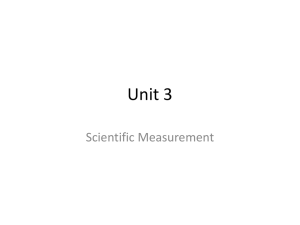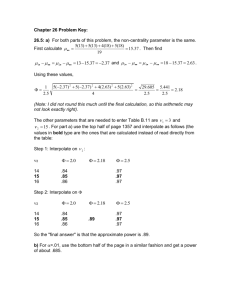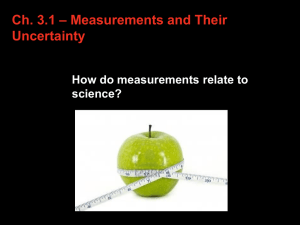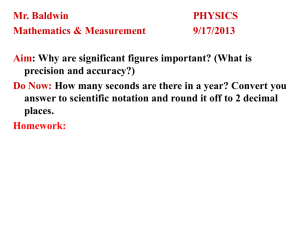2.2 Study of Strong Interactions
advertisement
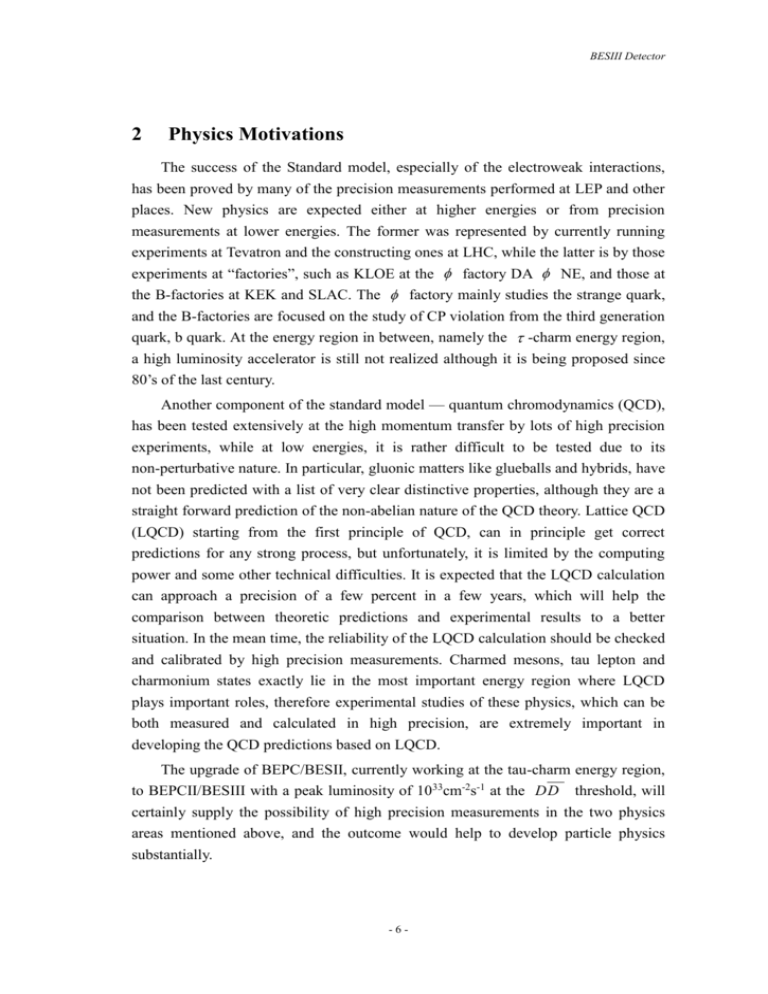
BESIII Detector 2 Physics Motivations The success of the Standard model, especially of the electroweak interactions, has been proved by many of the precision measurements performed at LEP and other places. New physics are expected either at higher energies or from precision measurements at lower energies. The former was represented by currently running experiments at Tevatron and the constructing ones at LHC, while the latter is by those experiments at “factories”, such as KLOE at the factory DA NE, and those at the B-factories at KEK and SLAC. The factory mainly studies the strange quark, and the B-factories are focused on the study of CP violation from the third generation quark, b quark. At the energy region in between, namely the -charm energy region, a high luminosity accelerator is still not realized although it is being proposed since 80’s of the last century. Another component of the standard model — quantum chromodynamics (QCD), has been tested extensively at the high momentum transfer by lots of high precision experiments, while at low energies, it is rather difficult to be tested due to its non-perturbative nature. In particular, gluonic matters like glueballs and hybrids, have not been predicted with a list of very clear distinctive properties, although they are a straight forward prediction of the non-abelian nature of the QCD theory. Lattice QCD (LQCD) starting from the first principle of QCD, can in principle get correct predictions for any strong process, but unfortunately, it is limited by the computing power and some other technical difficulties. It is expected that the LQCD calculation can approach a precision of a few percent in a few years, which will help the comparison between theoretic predictions and experimental results to a better situation. In the mean time, the reliability of the LQCD calculation should be checked and calibrated by high precision measurements. Charmed mesons, tau lepton and charmonium states exactly lie in the most important energy region where LQCD plays important roles, therefore experimental studies of these physics, which can be both measured and calculated in high precision, are extremely important in developing the QCD predictions based on LQCD. The upgrade of BEPC/BESII, currently working at the tau-charm energy region, to BEPCII/BESIII with a peak luminosity of 1033cm-2s-1 at the D D threshold, will certainly supply the possibility of high precision measurements in the two physics areas mentioned above, and the outcome would help to develop particle physics substantially. -6- BESIII Detector 2.1 Study of Electroweak Interactions The BESIII experiment working at the tau-charm energy region will test electroweak interactions with a very high precision in both quark and lepton sectors. 2.1.1 Precision Measurement of CKM Matrix Elements Quarks coupling to the weak interacting intermediate bosons are not mass eigenstates. This phenomena results in a transition matrix between weak interaction eigenstates and quark mass eigenstates. This was first proposed by Cabibbo[1], and extended by Kabayashi and Maskawa to the three-generation case[2]. The matrix is then called CKM matrix, d ' Vud s' Vcd b' V td Vus Vub d Vcs Vcb s Vts Vtb b d ' d where s ' is the weak interaction eigenstates, s is the mass eigenstates,and V b' b is a unitary matrix, which can be expressed by three mixing angles and one phase. As basic parameters of the standard model, the precision measurement of the matrix elements is of fundamental importance. From them, the completeness and effectiveness of theory can be guaranteed. Among those matrix elements relevant to the charm quark, Vcs and Vcd can be measured from the pure leptonic or semileptonic decays of Ds and D, and a precision of 1.6% and 1.8% can be achieved respectively at BESIII due to the large statistics and very high purity. Vcb which can be measured from B decays with D or D* in the final states, will benefit from the high precision measurements of the absolute D decay branching fractions, so to reduce the error from the tagging modes of B decays. With a combined efforts of both B factories and unquenched LQCD calculation of the form factor, Vcb can be measured to a precision of 3% . In determining the matrix elements Vtd and Vts from measuring B d B d and B s B s mixing, the decay constants fBd and fBs from theoretical calculations are used, since measurements of these two quantities are impossible at the moment. The known best way for improving the precision of the decay constant calculation is to calibrate the LQCD calculation of the decay constants of D and Ds—fD and fDs with high precision measurements. From the pure leptonic decays of D and Ds, the decay constants can be measured to a precision of 2% or less, this will help a lot in improving the precision of Vtd and Vts measurements. -7- BESIII Detector Since there are only four free parameters in the CKM matrix, the high precision measurements of all the matrix elements can be used as a check of the unitarity and normality condition of the matrix. Any significant deviation of measured values from the expectation may indicate the incompleteness of the CKM matrix, so to give a hint of the existence of new physics. Otherwise, if matrix elements satisfy all the requirements of the standard model, the mixing angles and the phase can be extracted from the measured values, and a higher precision transition matrix can be obtained. 2.1.2 Lepton Universality Due to the high selection efficiency and the high purity of the sample at Z0 peak, the tau physics study at Z0 energy has the advantage of small systematic error for channels with large branching fractions. While at B factories, the large statistics of the sample makes the study of channels with small branching ratios as well as the search for rare decays and new physics more suitable. At threshold, however, it has its own advantages due to the fact that pairs are produced at very low velocity. It can be used for some special physics studies, including the precision measurement of the tau lepton mass for the test of the lepton universality and interaction properties between the slowly moving tau pairs produced near threshold. The lepton universality is a basic, but very strong assumption in the standard Model. The assumption has been tested in very high precision with pure leptonic and semi-leptonic decays of taus and muons. Following the procedure of the tau mass measurement at BESI with the cross section measurement near the threshold, but with a much large statistics, BESIII can achieve a precision of 0.1MeV, an improvement of a factor 3 compared with that of the current world average. The precision will be far beyond what people can reach in tau lifetime and tau leptonic branching fraction measurements in the near future, and provide a foundation for a more precise test of the universality. It should be noted that the cross section near the threshold has been calculated toΟ(α4) in theory, taking into account the initial state radiation, Coulumb interaction between the tau pair and the high precision vacuum polarization estimation from hadron contributions. The precision is declared to be better than 0.1%[5],which can guarantee the final precision of the tau mass measurement where the observed production cross section as a function of tau mass was fit to the theoretical calculation. At the mean time, the measured cross section can be used to test the theoretical calculation of the cross section, especially the non-relativistic QED (NRQED) calculation of the interaction. This will supply us a better -8- BESIII Detector understanding of the interaction near the threshold. 2.2 Study of Strong Interactions Due to the non-perturbative nature of the strong interaction at the tau-charm energy region, almost all the theoretical calculations in this energy range have large uncertainties. LQCD will provide high precision predictions in a few years. But due to the limitation of computing capacity and complexity, the results will still be quite limited. As a consequence, all kinds of phenomenology models will still exist for a pretty long period of time, and even play important roles in some cases for the interpretation of experimental results. The study of QCD in the tau-charm energy region includes following aspects: determination of basic QCD parameters such as the strong coupling constant as , the mass of the charm quark mc, the high precision measurement of the light hadron spectroscopy, searching for gluonic states such as glueballs and hybrids, and the study of charmonium physics by measuring the production and decay properties of the charmonium states to test and develop QCD calculations. 2.2.1 Precision Measurement of Basic QCD Parameters In principle, the strong coupling constant s can be measured in any strong interaction process provided there exist good measurable quantities and reliable theoretical calculations. At BESIII, the most probable processes which may give high precision measurements of s include: inclusive J/ radiative decays, decays and hadronic cross section measurements (R value). The s at c-quark mass can be measured with inclusive J/ radiative decays, but the precision depends strongly on that of theoretical predictions, as well as that of the charm quark mass. The former one is expected to be taken care of by the development of LQCD, while the latter one can be determined by the much accurate charmonium spectroscopy and high precision theoretical calculations. The measurement of s with tau decays currently gives the best precision at a mass scale as low as the tau mass, by using the high precision measurement of the leptonic branching ratios and spectral functions, with the help of the Operator Product Extension in the theoretical calculation. Although it is very hard to improve the tau decay branching ratios at BESIII, the measurement of the spectral function with different systematic effects from previous experiments will contribute to the estimate of the strong coupling constant at the tau mass, as well as a test of running of the strong coupling constant at energies below the tau mass. Because QCD only contributes to the correction term of the R value, it is not -9- BESIII Detector easy to get a high precision s measurement with the R data. However since the statistical error will be completely negligible at BESIII for the R value measurement at any energy point and systematic errors excluding common ones are very small, the running of the strong coupling constant at the tau-charm energy region can be tested with a high precision. Furthermore, high precision measurement of R can be used to further improve calculations of the hadronic contribution in vacuum polarization, so to decrease the systematic uncertainties in the calculation of the abnormal magnetic moment of muon, aμ=(g-2)μ, and the running of the fine structure constant, α, and so on. 2.2.2 Study of the Light Hadron Spectroscopy Hadronic states are the basic components of the QCD at low energies, they reflect the strong interaction between quarks within the states. Although the study has a very long history, the understanding of the nature of interactions is rather poor, especially not accurate. In addition, QCD predicts the existence of gluonic states like glueballs and hybrids, which have not been experimentally observed or identified unambiguously. It is still one of the hot topics in particle physics in recent years. The radiative decay of J/ is considered as one of the best places for glueball production naïvely, and lots of experimental searches have been performed with the collected J/ data. Since glueballs are in the same mass range as normal hadronic states, and there is no conclusive signature predicted, their identification is very difficult, although some candidates were reported over a long period of time. At BESIII, the J/ sample will be two orders of magnitudes more than that currently collected, and the detector has a better acceptance and resolution, a much more sophisticated partial wave analysis (PWA) for those interesting decay channels can be performed. It is not impossible to systematically study the production and decay properties of the identified glueballs to test the QCD expectations provided glueballs are identified. At the mean time, other QCD predicted non q-qbar states like hybrids and four-quark states can be searched and studied with J/ decays. As an important by-product, systematic studies of normal meson states, high precision measurements of resonance parameters, production and decay properties of light mesons will play important roles in the test and development of the QCD in non-perturbative domain, especially in the development of the LQCD to which the high precision data will be a good calibration. Also, the experimental study of the baryonic states with J/ and possibly other charmonium decays will result in a better understanding of the strong interactions between mesons and baryons, so to supply interesting information for nuclear physics. - 10 - BESIII Detector It should be noted that, although glueballs are expected to be substantially produced in J/ radiative decays, the study of other hadronic states can be done in a very different environment, such as in J/ hadronic decays, non-leptonic decays of D or Ds, the decays of (2S) and the charmonium production from (2S) decays, as well as the semi-leptonic decays of the tau lepton. 2.2.3 Charmonium Physics J/ 、 (2S)、 (3770) and the charmonium states from their decays can be used to test the QCD by measuring their production and decay properties with the large data sample. The potential model and the non-relativistic QCD (NRQCD) color-octet mechanism play important roles in production and decays of quarkonium states, and lots of detailed information of the theory, including some crucial input parameters like the color-octet matrix elements need to be determined from experiments. A systematic study of the charmonium states below D D threshold will hence provide theoretical input parameters and further test other predictions from the theory. The P wave spin singlet 1P1 state has been predicted soon after the discovery of the charmonium, but searches for this state have not be given solid results although candidates have been reported by a few experiments. This state will help us to understand the details of the potential between quark pairs in the charmonium states, and will complete the charmonium spectrum below D D threshold. The high precision measurement of the resonance parameters of other charmonium states, together with their production rates and decay modes, will supply substantial experimental information for testing theoretical models, and help the development of theories. It should be noted that the large data sample collected at the B factories can be used for the charmonium physics study, including the search for the missing charmonium spin-singlet states, but the systematic study of these states will be better performed at BESIII since the data sample is much large and the background level is lower. The study of the charmonium decay dynamics is another important topic. It has been revealed that the charmonium spin-triplet state J/ and its radially excited state (2s) have very different decay patterns in some of the hadonic channels, compared with the naïve QCD prediction. The vector-pseudoscalor (VP) decays of (2s) were found to be significantly suppressed related to the decays of J/ , the so called “ puzzle". Further experimental study shows that not only the VP mode, but also the vector-tensor (VT) decay mode is suppressed, although the strength is a bit weaker. Current experimental studies are still limited by the statistics. At BESIII, the large - 11 - BESIII Detector data samples at J/ 、 (2S) and (3770) resonances and the nearby continuum will allow the measurements of all the interesting hadronic decay modes to a level similar to that of electromagnetic interactions, and different decay rates of these three charmonium states with different quantum numbers can be compared after non-resonance contributions subtracted. It is possible then to explain how the QCD works in charmonium decays, and to understand finally the “ puzzle”. 2.3 Search for New Physics Rare decays and processes not allowed by the standard Model can be searched for with the high statistics data sample to detect new physics or give constraints of new physics contributions. At the tau-charm energy region, there are lots of possibilities to search for new physics effect. Here we only list the single DS or D production, lepton and baryon number violation processes in J/ decays, D 0 D 0 mixing and the flavor changing neutral current (FCNC) with D data. 2.3.1 J/ψ Decays In standard model, the weak decays of J/ to single DS or D has the branching ratio of the order of 10-8. At BESIII, with 1010 J/ events in one year’s running, the decays can be observed and the test of the direct theoretical prediction can be made. Most importantly, if the observed production rate deviates significantly from the expectation, either enhanced or suppressed, it indicates the existence of other dynamics, or new physics. In standard model, the lepton number and the baryon number are conserved exactly. Very stringent limits have been set from Z0、τ and μ decays. With the large data sample at BESIII, the upper limits of J/ → e 、 e 、 、ep、 p、 p and so on can be set to the level of 10-9, so to give a stringent limit for theories beyond the standard model, or restrict the parameter space of non-standard models. It has been pointed out long time ago that the spin correlation between two separated spin half particles can be used to measure the Bell’s inequality so that to test the quantum theory[6]. A few hundred c→ were expected to give a good precision, while a much larger c → sample can be obtained at BESIII. A careful study will give an unambiguous answer to the question, and supply the first test of the Bell’s inequality in particle physics. 2.3.2 D Decays The Standard Model predicts a very small D 0 D 0 mixing probability and a small direct CP violation in DS or D decays, while new physics may enhance the - 12 - BESIII Detector effect dramatically. A careful study of D 0 D 0 mixing from (3770)decays can reach a mixing probability of 10-4, which, although still far away from the standard model prediction of 10-9, give a constraint to new physics contributions. The new physics search can also be performed through the measurement of FCNC modes. Standard model predicts the decay rates of D→ e e 、 、 e e 、 being of the order of 10-6 [7],which can be reached with the BESIII statistics. The test of these predictions with experimental measurements will reveal possible effects due to new physics. In summary, the construction of a high luminosity accelerator and high performance detector at tau-charm energy region opens a new window for high precision measurements of the electroweak interactions through the study of the charm mesons and the tau lepton, high precision study of the perturbative and non-perturbative QCD with J/ and other charmonium decays, and new physics searches. All these studies will supply more high quality tests of the standard model and give constraints to or hints on the new physics. In the following sections, detailed study of physics reach at BESIII is discussed, with some simulation results. Reference [1] N.Cabibbo,Phy.Rev.Lett.10,531(1963). [2] M.Kobayashi and T.Maskawa,Prog.Theo.Phys.49, 652(1973). [3] M.Artuso, Nucl.Instrum.Meth.A462 , 307(2001). [4] S.R.Sharpe, hep-lat/9811006, Plenary talk at ICHEP98. [5] P.Ruiz-Femenia and A.Pich, Phys.Rev.D64,053001(2001). [6] N.A.Toernqvist, Found. Of Phys., 11, 171(1981). [7] G.Burdman et. al., hep-ph/0112235. - 13 -


